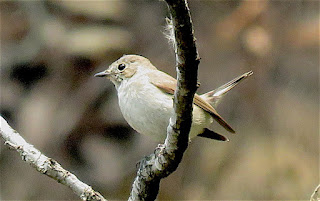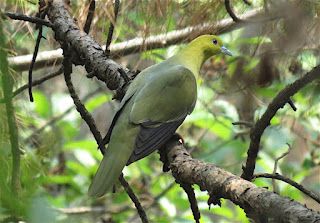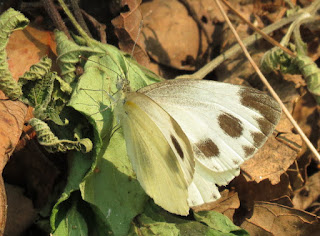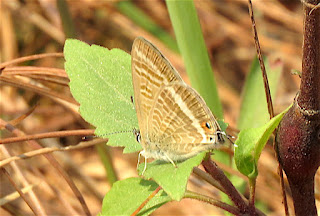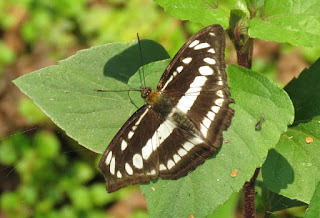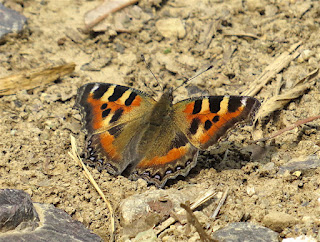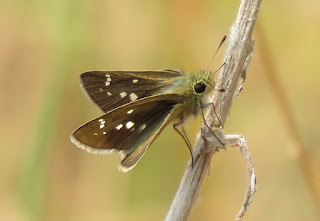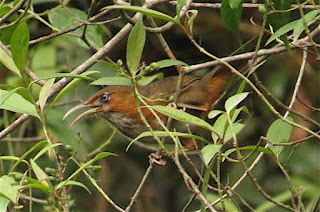The timing
of my arrival here in Kathmandu, Nepal was fortunately just right. Having
arrived on a Thursday evening, my first full day was a Friday, when my friends
Kate and Mich had to go to work. Perfect time to me to begin the long process
of getting over my jet lag (Nepal Time Zone is 12 hours and 45 minutes ahead of
Mountain Time Zone). I birded a
bit in the yard, seeing my lifer Oriental White-eyes as well as a few birds I
had seen in years past but didn’t know well: Oriental Magpie-Robin, House Crow,
Common Myna, Common Tailorbird, and two migrant Greenish Warblers. Both House
Sparrows and Eurasian Tree Sparrows are common and the ubiquitous feral Rock
Pigeon abundant. Black Kites are always overhead, and Rose-ringed Parakeets fly by frequently.
Then on
Saturday, the whole family and I took a late morning hike to Shivapuri National
Park, a very short drive to the edge of the city. Kate, Mich, Mara, and Malcolm.
It was just a dirt road
through some nice forest, and we walked about a mile and back over the
course of about 3 hours. It was light birding, as we took time to entertain the
kids, Kate fed Malcolm, and we looked at damselflies, grasshoppers, and
beetles.
I was a bit
overwhelmed with 27 lifebirds, mostly names I had never heard before. (I must
admit I did not have a chance to study at all for this trip.) Mich has been
throwing names at me like “tesia” and “niltava,” and I have no idea what he is
talking about. Now I know how some of my participants felt when we saw a
Double-striped Thick-knee in Costa Rica last month, and they had never heard of
the word. “Double-striped WHAT?” I
swore Mich made up the name Blue-winged Minla, but I actually saw one.
Here are
some photos of the birds we saw – all of them new for me.
This Common
Hawk-Cuckoo was singing very loudly right over the road as we were driving up.
This
Blue-capped Rock-Thrush was a surprise for Mich, as it is apparently a migrant
that had only recently arrived.
The
Long-tailed Minivet is relatively common and conspicuous, and I noticed that
its excited call reminds me of Helmeted Manakin.
A very
common bird in small mixed flocks is the Nepal Fulvetta. (Whatever a fulvetta
is…)
A male Small
Niltava – one of the prettiest birds of the forest here.
Not nearly
as colorful, this probable female Taiga Flycatcher was a recent arrival.
We were
lucky to find a pair of Spotted Forktails along a rivulet. We don’t have
anything remotely resembling forktails in the New World, and now that I’ve seen
three species (two in Borneo three years ago), I’ve decided I still have no idea
what a forktail is. But I like them.
It took me a
while to track down this Golden-throated Barbet, as it was singing from the top
of an alder tree and sitting very still.
Finally,
while I was trying to track down the barbet, Mich spotted this perched female
Wedge-tailed Pigeon, a new bird for him.
Butterflies
were surprisingly common, and I managed to get at least tentative names for
most of them:
Pieris brassicae nepalensis, Nepalese
Large Cabbage White
Metaporia agathon, Great Blackwing
Acytolepis puspa, Common Hedge Blue
Lampides boeticus, Pea Blue
Athyma opalina orientalis, Himalayan Sargeant
Callerebia annada caeca, Nepal Ringed
Argus
Aglais cashmirensis aesis, Indian Tortoiseshell
Precis iphita, Chocolate Pansy
Symbrenthia lilaea khasiana, Common
Jester
A grass
skipper, maybe Thoressa aina
Then on
Sunday, Mich and I were joined by Som GC, perhaps Nepal’s best known birding
tour leader, to spend a few hours in the morning at Phulchoki, a lovely
forested hill southeast of the city. Incidentally, since Nepali is an Indo-European language, it's not surprising to see there are many cognates with European languages. Phulchoki means flower-full. Chock full of flowers.
The dawn song was overwhelming, and mixed
flocks were everywhere. I saw another 44 lifers in just 5 hours, but I had the feeling there
were just as many that we passed up. I really look forward to knowing these
birds better. Here are the ones I managed to photograph:
Green-tailed
Sunbird – this male was all riled up at our pishing and owl imitations.
Himalayan
Cuckoo – an amazing spot by Som, perched a couple hundred meters away. We heard
them all morning, but saw only this one and another in flight.
Nepal
Fulvetta – like yesterday, we had
several flocks of these. It's a simple looking bird, but I could get used to seeing these every day.
Orange-bellied
Leafbird – I had seen this yesterday, but only fleetingly.
Rusty-cheeked
Scimitar-Babbler – a great name for a great bird, usually very hard to see.
Tickell's
Leaf Warbler – I don’t know how I managed to get a photo of this, one of the
better warblers we saw (and probably a migrant here), and a constant flitter in the tops of trees. We saw thirteen species
of birds called “warbler,” including eight in the genus Phylloscopus, to which belongs this Tickell’s.
Ultramarine
Flycatcher
Verditer
Flycatcher
Three birds
that I didn’t photograph but must mention for their cuteness are Pygmy Cupwing
(formerly called Pygmy Wren-babbler), Gray-bellied Tesia, and Chestnut-headed
Tesia. All are tiny things that live on or near the ground in dense thickets, have very short
tails and long legs, and resemble a cross between an antpitta and a winter
wren. They can be hard to see. The tesias are now in the bush-warbler family (Cettiidae), and the
cupwings are a genetically distinct group of five species that were recently
removed from the babbler family and placed in their own (Pnoepygidae), and them
moved in the order to be placed closer to distant relatives, the kinglets and
the African warblers. Incidentally, “pyga” means rump in Latin, but I don’t
know the meaning of “pnoe.”
We also saw a
few more butterflies, but it was cooler and shadier than Shivapura.
Byasa dasarada, Great Windmill. I had
seen this swallowtail yesterday but didn’t get a photograph good enough to ID
it.
Colias fieldii, Dark Clouded Yellow
I also saw a
stunning birdwing swallowtail, but there are two species that are very similar.
There is no
good field guide to the reptiles of Nepal, so this lizard may remain
unidentified for some time.
This
delicate bush in the mint family smelled strongly of pennyroyal, sort of a
cross between peppermint and basil.
As it got
warmer, these beautiful yellow-winged cicadas began making a clicking sound,
rather different from the majority of species that have a long, continuous
buzz.
















